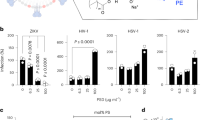Abstract
Most of the organisms of the phylum Nematoda are free living, but some are animal or plant parasites of major importance to man. During their life cycle all nematodes undergo a series of moults in which they shed an external cuticle, consisting of an outermost membrane-like layer of unknown composition and a series of fibrillar layers similar to collagens1–4. Because of this structure, the cuticle has been viewed as an acellular exo-skeleton1 with rather inert molecular components. However, observations have shown that it contains enzymes and sometimes haemoglobin3,4, and that nutrients are absorbed through it in the infective larvae and adult stages of Brugia pahangi5. It is bound by complement and antibody, resulting in the adherence of leukocytes6, and antibody-dependent cell-mediated reactions damage the cuticule of newborn larvae of Trichinella spiralis7–9 and the microfilariae of Dipetalonema viteae and Litomosoides carinii10,11. We report here that the surface of the cuticle of the parasitic nematode Trichinella spiralis expresses protein molecules which change qualitatively following the moulting process, and quantitatively during growth of the worms within one stage. Also, surface proteins are released in vitro at a rate which depends on the conditions of culture of the worms.
This is a preview of subscription content, access via your institution
Access options
Subscribe to this journal
Receive 51 print issues and online access
$199.00 per year
only $3.90 per issue
Buy this article
- Purchase on Springer Link
- Instant access to full article PDF
Prices may be subject to local taxes which are calculated during checkout
Similar content being viewed by others
References
Lumsden, R. D. Expl Parasit. 37, 267–339 (1975).
Bird, A. F. The Structure of Nematodes (Academic, New York, 1971).
Lee, D. L. Adv. Parasit. 4, 137–254 (1966).
Lee, D. L. Adv. Parasit. 10, 347–379 (1972).
Chen, S. N. & Howells, R. E. Parasitology 78, 343–354 (1979).
Soulsby, E. Pathology of Parasitic Diseases (ed. Gaafar, S.) 243–257 (Purdue University Studies, Lafayette, Indiana 1971).
Mackenzie, C. D., Preston, P. M. & Ogilvie, B. M. Nature 276, 826–828 (1978).
Kazura, J. W. & Grove, D. T. Nature 274, 588–589 (1978).
Kazura, J. W. & Aikawa, M. J. Immunology 124, 355–361 (1980).
Tanner, M. & Weiss, N. Acta tropica 35, 151–160 (1978).
Subrahmanyam, D., Mehta, K., Nelson, D. S., Rao, Y. V. B. E. & Rao, C. K. J. clin. Microbiol. 8, 228–232 (1978).
Dennis, D. T., Despommier, D. D. & Davis, N. J. Parasit. 56, 974–977 (1970).
Author information
Authors and Affiliations
Rights and permissions
About this article
Cite this article
Philipp, M., Parkhouse, R. & Ogilvie, B. Changing proteins on the surface of a parasitic nematode. Nature 287, 538–540 (1980). https://doi.org/10.1038/287538a0
Received:
Accepted:
Issue Date:
DOI: https://doi.org/10.1038/287538a0
This article is cited by
-
Trichinella britovi muscle larvae and adult worms: stage-specific and common antigens detected by two-dimensional gel electrophoresis-based immunoblotting
Parasites & Vectors (2018)
-
Blocking anti-trichinella spiralis antibodies in chronically infected rats
Parasitology Research (1996)
-
Immunocytochemical localization of antigens in adult worms ofTrichinella spiralis recognized by Fischer rats
Parasitology Research (1994)
-
Excretory‐secretory antigens from adult Nematospiroides dubius
Immunology & Cell Biology (1989)
-
Preotection againstTrichinella spiralis induced by purified stage-specific surface antigens of infective larvae
Parasitology Research (1989)
Comments
By submitting a comment you agree to abide by our Terms and Community Guidelines. If you find something abusive or that does not comply with our terms or guidelines please flag it as inappropriate.



